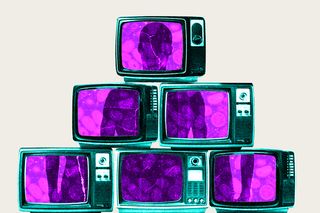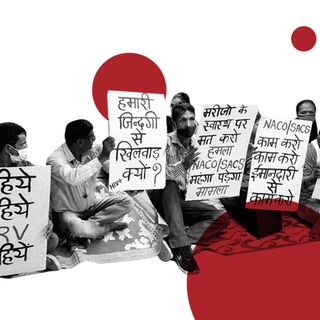
Why Misrepresenting Monkeypox as a Sexually Transmitted Disease Is Dangerous to Public Health
People need to be informed “that monkeypox spreads through close contact with an infected person, which includes sex but is not limited to it.”

In 1980s Australia, public health advertisements portrayed the Grim Reaper as a stereotypically gay man. The morbid image was meant to personify the fear around the then little-understood HIV epidemic. Today, it is a cautionary tale on how not to spread stigma in public health messaging.
However, some 40 years later, the new monkeypox outbreak is witnessing a similar media misrepresentation. On July 24th, a day after India confirmed three cases of the virus, suspicious news clippings appeared on chipped walls in Kerala’s Alappuzha. One referred to the monkeypox vaccine being provided to gay and bisexual men in other countries. Other posters stated that there was a new sexually transmitted disease on the rise. Next to them stood cut-outs depicting a man and a woman holding an umbrella over two children, “protecting” them from rainbow-colored rain.
Within a few weeks of the monkeypox outbreak becoming global, significant concerns have been raised about stigmatizing portrayals. Since the virus is endemic to African countries, Western media reports were replete with racism and bias in their framing. Further, since the first few cases were reported in gay and bisexual men, the panicked public response has been to misinterpret it as a sexually transmitted infection or a “gay disease.”
“Over the last two and a half years, both the media as well as the readers have become wiser on public health… With that in place, we expected the media, both international and local, to act more responsibly when talking about messaging around monkeypox virus disease,” says Dr. Aqsa Shaikh, an associate professor of community medicine at Hamdard Institute of Medicinal Science and Research. “But what it seems is we are making the same mistakes that we have made in the past – while talking about HIV or SARS-CoV-2.”
The outbreak thus raises questions about how we can separate stigma from evolving health advice. Framing monkeypox as an infection that spreads only among some communities, namely among queer men, is inimical to both public and personal health.
What we know about monkeypox so far
Monkeypox is related to the virus that causes smallpox, but its symptoms are not as severe. It presents as fever, headaches, muscle aches, chills, swollen lymph nodes, and most visibly as rashes. Largely, monkeypox is treatable and requires isolation and social distancing – both of which we are now seasoned in – for people to get better within a span of a few weeks. Only less than 10% of cases historically have been fatal.
Monkeypox is not a novel disease, but its current outbreak is baffling. While it was endemic to parts of western and central Africa earlier, various strains of monkeypox now appear to be spreading in different geographies and among people with no history of travel. As of July 23rd, 2022, the World Health Organization recorded more than 16,000 monkeypox cases in 75 countries. It declared monkeypox a global health emergency, casting the threat significant enough to call for an internally coordinated response. (The last time a similar call was raised was in January 2020, to respond to a then-mysterious SARS-CoV-2 virus).
Related on The Swaddle:
Global Media Coverage of Monkeypox is Rooted in Racism, Homophobia
As of July 26th, India has four confirmed cases of monkeypox.
The World Health Organization on Saturday noted monkeypox cases are concentrated in men having sex with other men. But it also mentions that “while close physical contact is a well-known risk factor for transmission, it is unclear at this time if monkeypox can be transmitted specifically through sexual transmission routes. Studies are needed to better understand this risk.”
But “the virus transmission has absolutely nothing to do with one’s sexual orientation,” notes Dr. Sakshi Mamgain, a queer-affirmative and trauma-informed physician, and co-founder of UTH-United for Transgender Health.
Why monkeypox is misinterpreted as a sexually transmitted disease
The outbreak has already succumbed to wide misinterpretation. “Observing the concentrated cases from a specific community was just an epidemiological reflection, since the recent outbreaks were both in a setting where the majority of the population comprised of ‘men who have sex with men,’” explains Dr. Mamgain.
This attribute is key: that infection spread is strongly subjective to the scale of interaction. Dr. Swapneil Parikh, a physician, notes that: “if there is an interaction of a larger number of people – regardless of whether those are men with men, women with women, or men with women – the more the number of contacts, the more likely one is to get infected. Especially when that contact occurs because of not taking the necessary precautions. That’s something that was similar to Covid19.”
Given that the outbreaks in the U.S. and Europe were traced back to a pride event and a fetish festival, it was the scale of interaction that increased the risk of infection. In other words, “even if the monkeypox disease is found more in men having sex with men, that does not mean that it is necessarily a causative factor,” notes Dr. Shaikh.
Moreover, testing also plays a major role in framing the narrative. “A lot of the data we have right now is really just based on where testing is occurring and where we’re looking for cases,” says Dr. Parikh. “If we look for cases only in a particular network, we may miss cases in other networks. While it’s important to allocate resources to disproportionately impacted communities, we must not assume other communities will not have transmission. Currently, cases are concentrated in the MSM [men who have sex with other men] network but as Monkeypox begins to spread, we’ll start seeing cases in other networks too.”
A cursory knowledge of the global history of public health will tell us how susceptible we are to miss this fact: that confirmed cases are tied to variables of testing, epidemiological evidence available at the time, social interactions of said people. Yet, the desire to assign blame hastily and unthinkingly is deep-rooted. Both HIV outbreak and Covid19 provide an unsettling echo of the mistakes made in reporting and talking about infectious diseases.
“The LGBTQIA+ community is still recovering from the stigma that came with the AIDS crisis,” notes Dr. Mamgain. The media was complicit in framing a homophobic response to the HIV/AIDS crisis; through words and images, people living with HIV were framed as the menacing “other.” Just like AIDS, monkeypox is an “epidemic of meaning too,” in the words of American scholar Paula Treichler.
According to Dr. Shaikh, we need to be extremely cautious now, before people in India start calling it the “gay disease,” which is already happening in some parts. This will further impact the discourse on rights available to stigmatized groups – such as who has the right to marry or what kind of welfare opportunities and access are available to trans communities. “This kind of media reporting can shift the societal perceptions towards the gender and sexual minorities,” Dr. Shaikh worries.
How misinformation can fuel a larger public health crisis
This is not only a humanitarian argument but a public health one too. On one level, framing monkeypox as an infection that affects some communities only can also create a false sense of security in individuals who come from different communities. “If someone thinks that this is just a disease of queer identity, if that’s how it is looked at, an individual may think that heterosexual contact with a large number of partners doesn’t lead to risk, which can endanger themselves,” Dr. Parikh notes. It can lead people to not give much importance to the symptoms.
We saw this with Covid19, when people were quick to eschew masks or sanitizers, casting a pandemic as the mere flu. Sayantan Datta also wrote in The Swaddle about a similar story playing out in India’s HIV/AIDS intervention policy: “Because HIV/AIDS was not considered a possibility in the context of ‘traditional’ monogamous marriages, married women who were at a high risk of contracting HIV from their promiscuous husbands were not included in ‘high-risk’ categories for a long time.” This led to “many people who were at a high-risk of contracting HIV were not paid attention to due to a lack of engagement from both the state and the HIV/AIDS intervention movement itself.”
Related on The Swaddle:
These are the pitfalls of trying to build spurious associations where it does not exist. Although human-to-human transmissions of Monkeypox are rare, they can happen through close physical contact. “We need to ensure plain understanding in the general population that monkeypox spreads through close contact with an infected person, which includes sex but is not limited to it,” says Dr. Mamgain.
The misinformation around monkeypox being an STI also shrouds the other potential ways people can be infected. “Shared clothing or bedding can also result in transmission and it can spread to everyone, regardless of their gender or sexual orientation or age,” Dr. Mamgain clarifies. Anyone can catch it by touching items that are contaminated (like clothing), or from respiratory droplets (hence, masks), skin-to-skin or mouth-to-mouth contact with an infected individual.
Secondly, homophobic portrayals in the media and by public health experts may discourage people with symptoms from coming forward. “Because when a particular community is falsely associated with a particular disease, it adds to the stigmatization, leads to lesser people from that community coming forward with these symptoms, they’re more likely to go into hiding, and therefore, unfortunately, continue to spread the diseases,” explains Dr. Shaikh. Stigmatizing language can then compromise disease response overall.
The role and responsibility of media
An Indian news article on Monday was sensationally headlined as “Is it an STD? How does it spread? All about Monkeypox.” Any ethicist will point out how misinformation needs to be debunked, not reinforced as is. “When it comes to the responsibility of the media while talking about pandemics, about infectious diseases, that is still missing,” notes Dr. Shaikh. The media is critical in the exercise of constructing a disease, and making it intelligible for people to grasp the implications. “This is why we need to talk about this – to reflect on how things should have been, how things are currently, and what are the gaps in reporting. Especially when it involves stigmatized people from the community, such as gender and sexual minorities.”
“I have already come across articles from Indian media houses with stigmatizing language that puts our community at the risk of being labeled as carriers of this ‘gay virus,’” says Dr. Sakshi Mamgain. Internationally too, some media reporting and commentary were reinforcing homophobic and discriminatory stereotypes.
It raises the question of how the media and even public health officials should talk about an evolving infection. “Accurate reporting is not always sensitive reporting, and sensitive reporting is not always responsible reporting. What the media needs currently is a balance between these three aspects,” says Dr. Shaikh.
This balance, however, can be tricky to enact in reality – it demands care in how we communicate so as to avoid stigmatizing communities that we are essentially trying to reach out to. For instance, a more responsible way would have been to frame affected people as those who are at a “higher risk” of disease because of their lifestyle and socializing habits rather than casting them as “spreaders” of a disease.
“We need to communicate the information sensitively, without inducing panic or mistrust,” says Dr. Mamgain. “The virus does not recognize global borders or social networks. It is misguided to attribute it to any particular group and immoral, even, to assign blame.”
Dr. Parikh points out how it’s important to highlight that “it’s not just [queer] communities that can get monkeypox… it is something that impacts everyone in your area.” So the idea is to promote messaging that will allow people to seek healthcare if they have certain symptoms. For the vast majority of people, monkeypox is not a huge risk and is even treatable. “So we also need to avoid causing undue panic.”
At the same time, “you also need to reach out to those specific communities in a way that they are willing to accept intervention. It is imperative to reach communities that may be disproportionately impacted so that they can protect themselves and be empowered with that information.”
This involves providing people with the knowledge of what the risks are, what the symptoms look like, and what they can do if they have come in contact with someone. “Individuals need to take certain measures to protect themselves, but we also need to build out the healthcare capacities to be able to serve those communities, which we don’t necessarily have in India yet. A lot of work needs to be done.”
The work, here, involves building testing capacities, analyzing patterns of modes of transmission, looking out for mutations, expanding the health apparatus for effective public health messaging, and mulling vaccination developments – all of which require accurate, sensitive, and responsible reporting too. A deliberate effort can help create an environment where people feel safe, come forward, report symptoms, and/or get tested and vaccinated.
It is hard to strip a bias down to its bare roots, and gape at its rawness. Times past, and times present, have presented us with the opportunity to do exactly just that. In 2002, two researchers looked at the history of public health over 200 years, and dishearteningly concluded it had all but foundered. “…where we are now with public health has been shaped by our earlier, limited, and crisis-focused responses to changing disease threats. We have failed to sustain progress in any coherent manner,” they wrote, articulating what they called the “unfulfilled promise of public health.” Public health was meant to be not only instructive, but also self-sustaining in its lessons. It was a deceptively simple takeaway: “if we do not wish to repeat past mistakes, we should learn lessons from the past to guide us in the future.”
Deceptive, because lessons are slow to translate, and even slower to learn from. And if lessons are adequately learned, Dr. Mamgain notes “stigma has no place in medicine – or public health.”
Saumya Kalia is an Associate Editor at The Swaddle. Her journalism and writing explore issues of social justice, digital sub-cultures, media ecosystem, literature, and memory as they cut across socio-cultural periods. You can reach her at @Saumya_Kalia.
Related


HIV Patients Are Protesting a Nationwide Shortage of Life‑Saving Medicines
